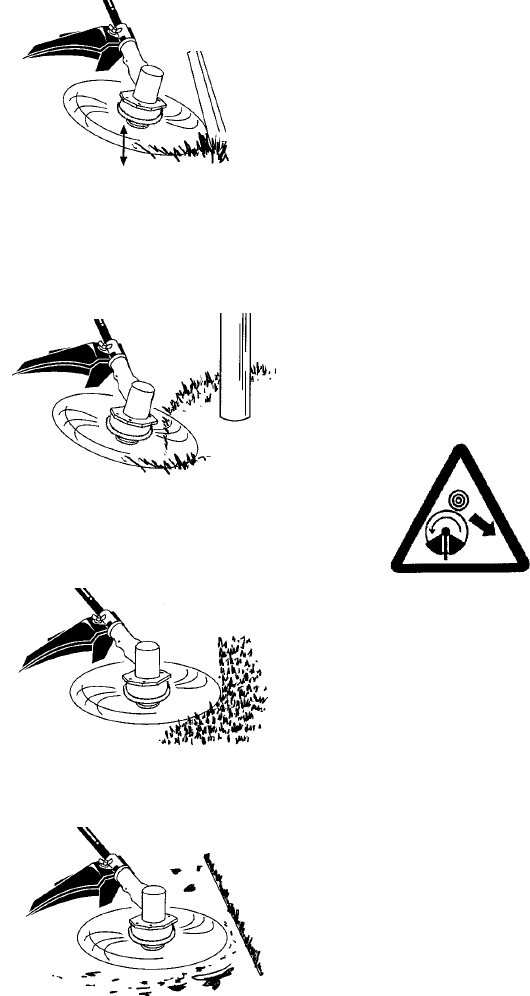
12
Trimming
3 inches (8 cm)
above g round
SCALPING -- The scalping technique removes
unwanted vegetation down to the ground. Hold
the bottom of the trimmer head about 3 in. (8
cm) abovetheground andat anangle. Allowthe
tip of the line to strike the ground around trees,
posts, monuments, etc. This technique in-
creases line wear .
Scalping
MOWING -- Your trimmer is ideal for mowing
in places conventional lawn mowers cannot
reach. In the mowing position, keep the line
parallel to the ground. Avoid pressing the
head into t h e ground as this can scalp the
ground and damage the tool.
Mowing
SWEEPING-- Thefanningactionof therotat-
inglinecanbeusedtoblowawayloosedebris
from an ar ea. Keep the line parallel to and
above the ar ea surface and swing the tool
from side to side.
Sweeping
OPERATING INSTRUCTIONS FOR
USE WITH WEED BLADE
S Blade Thru s t is a reaction that only occurs
when using a bladed unit. This reaction can
cause serious injury such as a mputation.
Carefully study this section. Itis importantthat
you understand what causes blade thrust,
how you can reduce the chance of its
occurring, and how you can remain in control
of unit if bl ade thrust occurs.
S WHA T CAUS ES BLAD E THRUS T -- Blade
Thrust can occur when the spinning b lade
contacts a n object that it does not cut. This
contact causes theblade tostopfor aninstant
and then suddenly move or “thrust” away
from t he object t hat was hit. The “thrusting”
reaction can be violent enough to cause the
operator to be propelled in any direction and
lose control of the unit. The uncontrolled unit
can cause serious injury if the blade contacts
the operator or others.
S WHEN BLADE THRUST OCCURS --
Blade Thrust can occur without warning if
the blade snags, stalls, or binds. This is
more likely to occur in a reas where it is
difficult to see t he material being cut. By
using the unit properly, the occurrence of
blade thrust will be reduced and the
operator will be less likely to lose control.
S Cut only grass, weeds, and woody brush up
to 1/2 inch (1 cm) in diameter with the weed
blade. Do not let the blade contact material it
cannot cut such as stumps, rocks, fences,
metal, etc., or clusters of hard, woody brush
having a diameter greater than 1 cm.
S Keep the blade sharp. A dull blade is more
likely to snag and thrust.
S Cut only at full throttle. The blade will have
maximumcutting powerand isless likelyto
bind or stall.
S “Feed” the blade deliberately and not t oo
rapidly.Thebladecanthrust a way ifit isfed
too rapidly .
S Cut only from your l eft toyour right. Cuttingon
right side of the shield will throw debris away
from the operator .
S Use the shoulder strap and keep a firm grip
on the unit with both hands. A properly
adjusted shoulder strap will support the
weight of the unit, freeing your arms and
hands to control and guidethe cutting motion.
S Keep feet comfortably spread apart and
braced for a possible sudden, rapid thrust of
unit. Do not overreach. Keep firm footing and
balance.
S Keep blade below waist level; it will be
easier to maintain control of unit.


















